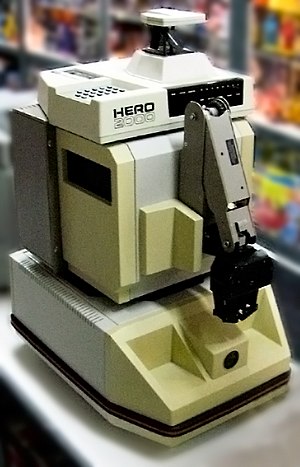HERO (robot)

HERO 1
|
|
| Manufacturer | Heathkit |
|---|---|
| Type | robot |
| Release date | 1982 |
| Introductory price |
Kit 1500 US$ (today $3722.59), Assembled 2500 US$ (today $6204.31) |
| Discontinued | 1995 |
| Units sold | 14,000(Sold over 8 years) |
| Media | Assembly manual, user's manual, technical manual, and speech dictionary |
| CPU | Motorola 6808 |
| Memory |
RAM: 4 kB, Monitor ROM: 2 kB |
| Storage | Compact Cassette |
| Display | six 7-segment LEDs |
| Sound | Votrax SC-01 speech synthesizer (Included with Assembled version and $149.95 option for kit) |
| Input | Hex keypad with 17 keys |
| Power |
Batteries: four 6-volt gel cell Charger: 120/240 VAC, 50/60 Hz charger |
| Dimensions | 20 inches high x 18 inches wide (50 cm x 45 cm) |
| Weight | 39 pounds (18 kg) |

Hero Jr. (with optional remote control)
|
|
| Manufacturer | Heathkit |
|---|---|
| Type | robot |
| Release date | 1984 |
| Introductory price |
Kit US$599.95, Assembled US$1000 |
| Discontinued | Before Oct 1987 (Assembled) 1995 (Kit) |
| Units sold | 4,000(Sold over 8 years) |
| CPU | Motorola 6808 1 MHz |
| Memory |
RAM: 2 kB, expandable to 24 kB Monitor ROM: 32 kB |
| Display | 9 LEDs |
| Sound | Votrax SC-01 speech synthesizer |
| Input | Hex keypad with 17 keys |
| Power | Batteries:6 V 3.8 A·h x2, x4 optional |
| Dimensions | 19 inch high |
| Weight | 21.5 pounds |

HERO 2000
|
|
| Manufacturer | Heathkit |
|---|---|
| Type | robot |
| Release date | 1986 |
| Introductory price |
Kit US$3000, Assembled US$4,500 |
| Discontinued | 1995 |
| Units sold | 3000(Sold over 8 years) |
| CPU |
Intel 8088(Main) 6 slave Z-80 processors (11 with optional Arm) |
| Memory |
RAM: 24 kB, expandable to 576 kB Monitor ROM: 64 kB with integrated BASIC |
| Display | sixteen head-mounted LED status indicators (eight are user definable) RS-232 serial port |
| Sound | Silicon Systems SSI 263 (analog formant) speech synthesizer |
| Input | hexadecimal keypad RS-232 serial port |
| Power |
Battery:single 24 amp-hour battery Charger: 120 VAC charger included |
| Dimensions | Height 32 inches (81 cm) |
| Weight | 78 pounds (35 kg) |

HE-RObot is a badge-engineered version of the 914 PC-Bot (pictured) by White Box Robotics.
|
|
| Developer | White Box Robotics |
|---|---|
| Manufacturer | Heathkit |
| Type | robot |
| Release date | 2007 |
| Introductory price | as much as $8000 |
| Discontinued | 2012 |
| Units sold | approximately 50 |
| Operating system | Windows XP Pro |
| CPU | Intel Core Duo |
| Memory | 1 GB DDR2 RAM |
| Storage | 80 GB 2½in. SATA Hard drive |
| Power |
Batteries: 2 x 12V 9Ah Lead Acid Battery Charger: SONEIL 12V Intelligent Battery Charger (3A) |
| Dimensions | Height 21 inches (53 cm) |
| Weight | 25 kg (55 lb) |
| Website |
www |
HERO (Heathkit Educational RObot) is the name of several educational robots sold by Heathkit during the 1980s. The Heath Company began the HERO 1 project in October 1979. The first units were available in 1982. Models included the HERO 1, HERO Jr., and HERO 2000. Heathkit supported the HERO robot line up until 1995. All three were available as kits, or for more money, prebuilt by Heathkit. Since 2013 the 1980s models are considered collectors items, due to their apparent rarity. For the most part, they cannot perform practical tasks, but are more geared toward entertainment and education above all.
HERO 1 was a self-contained mobile robot controlled by an onboard computer with a Motorola 6808 CPU and 4 kB of RAM. The robot featured light, sound, and motion detectors as well as a sonar ranging sensor. An optional arm mechanism and speech synthesizer was available for the kit form and included in the assembled form.
To make this power available in a simple way, high-level programming languages were created. For example, the ANDROTEXT language was a HERO 1 editor and compiler developed in 1982 for the IBM PC.
HERO 1 was featured on Mr. Wizard's World on a few episodes.BYTE called HERO 1 "a product of extraordinary flexibility and function ... If you are interested in robotics, Heath will show you the way".
A smaller version of HERO was released later, called HERO Jr. Heathkit intended it for the home market, and therefore made it less complex, and more self-contained. Like HERO 1, HERO Jr. had a 6808 processor, but only 2 kB of RAM. As well, it sported onboard speech synthesis, a Polaroid sonar range sensor, a light sensor, and a sound sensor. An optional infrared sensor was available as well. Other optional components included a pair of extra batteries to double the operational time between charges, from an estimated 4 hours to 8 hours. A remote control accessory allowed users to drive the robot around. It included a motion sensor that caused the robot to croak "SOM-THING-MOVE" when it detected a source of motion.
...
Wikipedia
